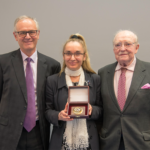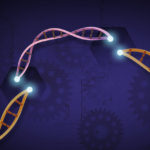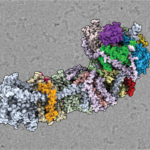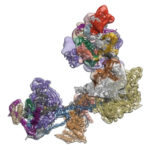During the annual Lorne Conference on Protein Structure and Function in Australia last month, Ian van Driel of the University of Melbourne (left) presented MBIB senior faculty scientist Eva Nogales (center) with the Grimwade Medal for Biochemistry for “visualizing the molecular dance at the heart of human gene expression.” The award is funded by the Grimwade family, pioneers in Australia’s pharmaceutical industry, of which Sir Andrew Grimwade (right) is a member. While in Australia, Nogales was a guest on the University of Melbourne’s “Eavesdrop on Experts” podcast. She spoke with host Steve Grimwade about using cryo-EM to understand cell behavior at the molecular level.
Two New Additions to CRISPR Toolkit
UC Berkeley and Berkeley Lab scientists have expanded the CRISPR gene-editing toolkit with the addition of a new, compact CRISPR-associated (Cas) protein—the RNA-guided “scissors” that snip DNA—and a modification of the Cas9 protein to give it an “on” switch for better control.
New Molecular Blueprint Advances Our Understanding of Photosynthesis
Researchers in the Molecular Biophysics and Integrated Bioimaging (MBIB) Division have used a state-of-the-art cryo-transmission electron microscope to reveal the structure of a large protein complex crucial to photosynthesis, the process by which plants convert sunlight into cellular energy.
Revealing the Shapes of Molecular Machines
Within each cell of the human body, thousands of molecular machines are at work. They transport nutrients and biochemicals into and out of our cells, build other tiny machines, and even move our cells around. To understand how these molecular machines work, scientists create three-dimensional pictures using electron cryomicroscopy (cryo-EM), catching these machines in different shapes that give insight into their function. Now researchers at Berkeley Lab and their international collaborators who write and distribute the Phenix software suite have developed a new set of computational tools for automated structure determination from cryo-EM data.
Freeze-frame Microscopy Captures Molecule’s ‘Lock-and-Load’ on DNA
Eva Nogales, faculty scientist in Molecular Biophysics & Integrated Bioimaging (MBIB) Division and UC Berkeley professor of molecular and cell biology, led a team that captured freeze-frames of the changing shape of a huge macromolecular complex as it locks onto DNA and loads the machinery for reading the genetic code. The molecule, called transcription factor IID (TFIID), is critical to transcribing genes into messenger RNA that will later be used as blueprints to make proteins.
- « Previous Page
- 1
- 2
- 3
- 4
- 5
- …
- 7
- Next Page »
Was this page useful?


